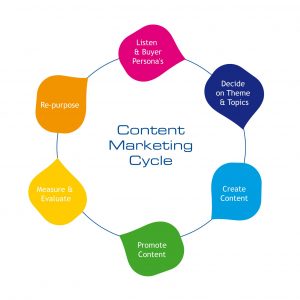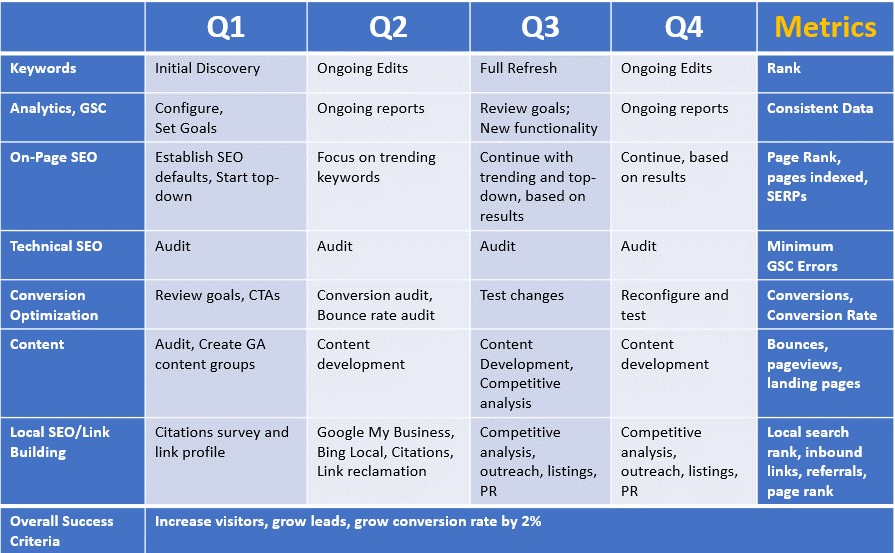How to Build an SEO Plan for Your Website
As a website or small business owner, you may question the need for an SEO plan. Or even if you should devote resources to SEO work altogether. Afterall, SEO takes forever, doesn’t it? And Google is pushing users to the paid ads, anyway, right? But search traffic is among the highest quality traffic you can deliver. And organic traffic in particular, remains one of the most effective sources of leads and sales. You will likely profit from both a paid search strategy and an organic. But users still click far more often on organic listings than on paid. And appearing at the top of Google organic results is like a badge of authenticity for your business. Appearing far below page 1 is like you don’t exist. So, you cannot leave your SEO to chance. You need an SEO plan and an SEO process, based on your specific business needs and market. Build it out over 6 months to a year, even though it will evolve over time. Define clear SEO goals and determine your metrics for success. And then execute, one step at a time. 
Before You Start SEO
SEO is a lifestyle. It requires a commitment. It is most definitely not a “set-it-and-forget-it” type of activity. And it’s not a faucet like Google Ads that generates traffic while it’s on and stops when you turn it off. You have to keep at it, like mowing the lawn. Stop, and you will lose control. And your competitors will overtake you. You must stay on top of it, understand the competitive landscape and how your users search. And you must tweak and optimize often to get to the top of the search results — and to stay there. So, decide before you start that you are in it for the long haul.
Establish Relevance and Authority
Google gives top rank to pages it sees as relevant and authoritative for any specific search. To that end, Google must be able to crawl and understand your site. And Google must have a reason to rank your site above other reasonable search results.
The Three Elements of Any SEO Plan
There are 3 key aspects to any SEO campaign:
- Technical SEO Optimization
- Content Optimization
- Conversion Rate Optimization
Technical optimization (or Tech SEO)
The practice of tech SEO strives to make it easy for users and search engines to navigate your site. You should review key technical components of the site for SEO compliance. This should include things like:
- code quality
- mobile performance
- meta tags
- site speed
- URL formation
- duplicate content
- pagination
These elements should work together to provide a satisfying user experience. And they should enable Google to quickly crawl and understand the site content. Find all easy to implement issues that are likely to have a significant impact. Those are your low-hanging fruit. Happy picking!
Content Optimization, Creation, and Curation
Content optimization includes creation of new content and curation and management of existing content. Start your SEO process by understanding how your website reflects your business. What is the unique value proposition (UVP) of your company? What problems do you solve for your customers? And why do they choose you over the competition? Is this made clear through a visit to your site? Is it clear no matter what page a first-time visitor lands on?
Understand and define your typical customers and how they search. What terms do they search for at the outset? Who is searching, and how will they behave when they arrive on your site? How do their searches change throughout the buyer’s journey? How do their content needs change as they progress closer to a buying decision? Ensure you have a solid grasp of the visitor personas and how they are most likely to engage with your site.
Select your keyword phrases. Map your keywords to your content. Where are the gaps? Focus your content around keyword searches relevant to each stage of the journey. Drop thin content, combine and cut duplicate content. Aim for every page to support a search or a deep dive by a user. And for every important cluster of search terms to have a corresponding page on your site. Get rid of pages not pulling their weight. Add new pages to fill the gaps for lost searches.
Note that if your business has a local brick and mortar address then build hyper local content. More and more users search on their phones, especially for local, “near-me” needs. At the same time, be sure your content is built for voice searches.
In general, write content for Google’s Direct Answer box with clear, full, bulleted answers to frequently asked user questions.
Conversion Rate Optimization
Conversion rate optimization (CRO) is the effort to optimize your site so more visitors “convert” to leads or sales. Say your website draws 10,000 visits each month and a conversion rate of 1.5%. That’s 150 leads or sales (or whatever a conversion is for you) per month.
10,000 x 1.5% = 150
Now you do some testing. You change the primary “CLICK HERE” or “ADD TO CART” button to bright yellow and the conversion rate lifts to 1.8%!
10,000 x 1.8% = 180
With a conversion rate increase of just .3% your success rate grows by 20%!
And you have not increased the traffic from the 10,000 visits it was already getting!
While attracting more users at the top of the funnel feels good, it’s not all that helpful if they don’t convert. We want to widen the funnel, so more visitors complete what they came for. Remove obstacles to conversion. Avoid distractions. Use analytics to learn where your traffic goes once people get to your site. And discover the drop-off points. Where do users exit and why? Your site should reveal an easy path to conversion for anyone, no matter how they arrived or where they landed in your site. Whatever their goals, wherever they are in the buying funnel, make sure the next steps are obvious and uncomplicated. Now go forth and multiply your conversions!
The Basic Building Blocks of an SEO Plan
Those are the three broad areas of SEO focus. An SEO campaign should successfully address the technical underpinnings of a site, understand and improve the content base, and ensure a smooth and easy path to conversion. Now we need to understand how to build an SEO work plan around these goals.
These are some of the key steps to consider in constructing your SEO process.
- Establish site goals and success metrics
- Keyword discovery
- Technical Audit
- Content Audit
- Conversion Audit
- Competitive analysis
- Optimize primary pages based on site sections and navigation
- Target trending and competitive keywords
- Local and link earning strategy
- Coordination with any PPC and remarketing efforts
- Regular reports on metrics and KPIS
SEO by Quarters
The chart below is an example of how you can lay these activities out over a 1-year campaign. Notice that some actions should repeat in later quarters. For example, it’s a good idea to follow up your initial keyword discovery with a full refresh a few months later. Keywords and goals evolve. Be sure you are still on goal and on track. And a technical audit will provide important and actionable insights every time! Do it at least once a quarter. Google crawls your site and provides continuous free feedback via Google Search Console (formerly Google Webmaster Tools). This is a valuable “conversation” to engage in. Do not ignore this free advice from Google.
It’s also going to be helpful to consider and note specific metrics for each activity, right in your chart. Then it will be easy to measure your success from month to month and quarter to quarter.

Final Notes – How’s Your SEO Plan Looking?
SEO is not mystical. There is really only one goal – make your site the best in your market. But the actual day to day work of SEO requires planning and often-times, expert execution. It may not be for the faint of heart. Do you have someone in-house? Do you outsource to the experts? What’s your SEO plan look like? How far out do you go? Share your tips and questions with us, and we’ll include them in a future post. Contact us today!
Recommended Related Reading
Video: Creating a SEO strategy (with Webmaster Tools!), By Maile Ohye, Developer Programs Tech Lead at Google
Content Planning 101: Making the Grade, by Rose Lanaro, OpenMoves
The Most Common SEO Pitfalls, by Brian Cooper, OpenMoves












